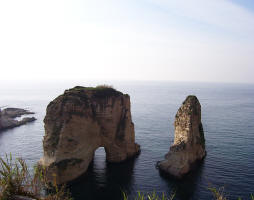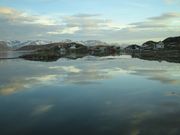 The Arab Spring and Climate Change: A Climate and Security Correlations Series
The Arab Spring and Climate Change: A Climate and Security Correlations Series
Over the past two decades, the role of planetary changes—the human impact on climate, biodiversity, and natural resources, from water to fish to forests—have exacerbated the perils of the human condition even as technological advances have created whole new worlds.
Crime-show devotees will be familiar with the idea of a “stressor”—a sudden change in circumstances or environment that interacts with a complicated psychological profile in a way that leads a previously quiescent person to become violent. The stressor is by no means the only cause of the crimes that ensue, but it is an important factor in a complex set of variables that ultimately lead to disaster.
“The Arab Spring and Climate Change” does not argue that climate change caused the revolutions that have shaken the Arab world over the past two years. But the essays collected in this slim volume make a compelling case that the consequences of climate change are stressors that can ignite a volatile mix of underlying causes that erupt into revolution.
This volume of essays includes the following contributions:
- Troy Sternberg of Oxford University begins by investigating the connections between climate events in other parts of the world and social unrest in the Arab world. More specifically, he looks at drought conditions in China, subsequent global wheat shortages, and how those shortages may have influenced the Egyptian uprisings. In his own words, he paints a picture of “how a localized hazard became globalized.”
- Sarah Johnstone and Jeffrey Mazo of the International Institute for Strategic Studies investigate the vulnerability of the Middle East and North Africa region to fluctuations of food supply and prices both globally and locally, and how current and projected climatic changes interact with those phenomena. They conclude that, “The Arab Spring would likely have come one way or another, but the context in which it did is not inconsequential. Global warming may not have caused the Arab Spring, but it may have made it come earlier.”
- Francesco Femia and Caitlin Werrell of the Center for Climate and Security address the influence of climate change before social and political unrest developed into large-scale conflict in Syria—a country many analysts initially deemed impervious to the Arab Spring, also known as the Arab Awakening—the projected influence of climate change after the Arab Awakening in Libya, and possible water-security solutions for building climate resilience that may simultaneously enhance cooperation and aid in resolving conflict.
- Michael Werz and Max Hoffman of the Center for American Progress investigate how “security in one place is irrevocably linked to stability in distant regions.” Werz and Hoffman use the Arab Awakening as a backdrop to explore how a 21st-century security strategy must account for “transcendent challenges,” including the nexus between climate change, human rights, and migration.
- David Michel and Mona Yacoubian of the Stimson Center explore how the Arab world could transform the risks posed by climate-change factors into sustainable economic growth and job-creating opportunities. Michel and Yacoubian look specifically at how “greening” Arab economies by adopting innovative technologies and forward-leaning government policies can simultaneously bolster employment and mitigate environmental risks, “turning two of the region’s pre-eminent challenges into a significant opportunity.”
All of these authors are admirably cautious in acknowledging the complexity of the events they are analyzing and the difficulty of drawing precise causal arrows. But consider the following statements:
- “A once-in-a-century winter drought in China contributed to global wheat shortages and skyrocketing bread prices in Egypt, the world’s largest wheat importer.” (Sternberg, p. 7)
- “Of the world’s major wheat-importing companies per capita, “the top nine importers are all in the Middle East; seven had political protests resulting in civilian deaths in 2011.” (Sternberg, p. 12)
- “The world is entering a period of ‘agflation,’ or inflation driven by rising prices for agricultural commodities.” (Johnstone and Mazo, p. 21)
- “Drought and desertification across much of the Sahel—northern Nigeria, for example, is losing 1,350 square miles a year to desertification—have undermined agricultural and pastoral livelihoods,” contributing to urbanization and massive flows of migrants. (Werz and Hoffman, p. 37)
- “As the region’s population continues to climb, water availability per capita is projected to plummet. … Rapid urban expansion across the Arab world increasingly risks overburdening existing infrastructure and outpacing local capacities to expand service.” (Michel and Yacoubian, p. 45)
- “We have reached the point where a regional climate event can have a global extent.” (Sternberg, p. 10)
These assertions are all essentially factual. None of them individually might be cause for alarm. Taken together, however, the phenomena they describe weave a complex web of conditions and interactions that help us understand the larger context for the Arab Awakening. Indeed, as Johnstone and Mazo argued as early as April–May 2011, in an article written just at the outset of the Tunisian and Egyptian revolutions, it was already possible to see that climate change played a role in the complex causality of the revolts spreading across the region. They called it a “threat multiplier.” It significantly increased the interactive effects—and hence the overall impact—of political, economic, religious, demographic, and ethnic forces.
This concept of a “threat multiplier” is a helpful way to think about climate change and security more broadly. In Syria, for instance, as Femia and Werrell tell us, a combination of “social, economic, environmental and climatic changes … eroded the social contract between citizen and government in the country, strengthened the case for the opposition movement, and irreparably damaged the legitimacy of the Assad regime.” In Libya, according to the same authors, Qaddafi used oil revenues to finance the “Great Man-Made River Project,” one of the largest water engineering projects in the world—and quite unsustainable. Libya is 93 percent arid, and the aquifers it is draining for the project are shared by Egypt, Chad, and Sudan. Moreover, climate projections estimate that Libya’s “drought days” per annum will rise from more than 100 to more than 200—an enormous and potentially devastating increase. It is not difficult to see how these conditions multiply the threats already facing Libya’s fragile new government. On the other hand, Femia and Werrell outline a much more positive vision of how water-management projects could help bring otherwise-divided parts of Libyan society together.
Beyond individual countries, if we accept the conclusions of the authors collected here, then we must expect a continuing and increasing interplay between climate, land, water, food, migration, urbanization, and economic, social, and political stress. Yet almost none of those issues shows up in a traditional course on international relations, which focuses far more on the traditional geopolitics of interstate relations, particularly the distribution of military and economic power among a handful of the most important states. Insecurity in this world is defined largely in terms of military threats posed by rising or declining powers; security dilemmas between rival states, which must assume worst-case motivations on one another’s part; physical and virtual terrorist attacks; and denial of access to any of the world’s common spaces—ocean, air, outer space, and, increasingly, cyberspace.
Yet intrastate violence, instability, and revolution all create their own turmoil. The geopolitical results of the Arab Awakening are felt in the political realignment of states such as Egypt following the political victory of the Muslim Brotherhood in recent elections, and the determination of states such as Saudi Arabia and Qatar to arm specific factions in the civil war in Syria as part of a proxy war with Iran. Moreover, violence and pervasive political uncertainty across the Middle East inflicts its own economic costs: unstable oil prices, streams of refugees and migrants to more developed countries, and the opportunity costs of investment forgone across a region that has served as a global crossroads since the beginning of human civilization.
It follows, as Werz and Hoffman conclude, that, “The United States, its allies, and the global community must de-emphasize traditional notions of hard security more suited to the Cold War and focus on more appropriate concepts such as human security, livelihood protection, and sustainable development.” Foreign policy initiatives focused on human-security issues offer ways to:
- Diminish distrust of the United States
- Bring together a wide range of civic and corporate partners, both in country and from abroad
- Transcend conflicts over resources such as water and grazing land among rival groups by creating avenues for constructive cooperation on issues including water management and crop adaptation
- Engage specific groups of a population such as women, youth, entrepreneurs, or religious communities
In response to this new emphasis on human security, Michel and Yacoubian detail a number of encouraging international initiatives to “establish networks of renewable energy projects linking Arab countries to each other and to export markets in Europe and Africa” and laying the foundations for green growth.
Former U.S. Secretary of State Hillary Clinton understood the value of this type of engagement from the very outset of her tenure. The first Quadrennial Diplomacy and Development Review in 2010 sought to develop and institutionalize new organizational structures and policy tools specifically designed to engage societies, as well as governments. Consider the creation of an under secretary for civilian security, democracy, and human rights replacing the under secretary for democracy and global affairs in the State Department. The new under secretary oversees five important bureaus, two of which—the Bureau of Counterterrorism and the Bureau of Conflict and Stabilization Operations—are newly created. The other three are the Bureau of International Narcotics and Law Enforcement, the Bureau of Democracy, Human Rights, and Labor, and the Bureau of Population, Refugees, and Migration. Each of these bureaus focuses on a different dimension of human security:
- Protection from violence in conflict-torn states and the rebuilding of state institutions
- Protection from the violence and corruption inflicted by global criminal networks in drugs, arms, money, people, and violent extremism
- Protection of basic human rights
- The meeting of basic human needs in times of migration and displacement
Within these bureaus and in offices reporting directly to the secretary of state can be found a host of new ambassadors and senior representatives for issues such as:
- Global empowerment of women
- Creation and maintenance of public-private partnerships
- Global youth issues
- Establishment of regional and global networks of entrepreneurs
- Outreach to Muslim communities around the world
- Support of civil society
The new Bureau of Energy Resources also focuses on energy security for the United States and its allies—a task that requires close coordination with the special representative for climate change.
These initiatives are far more than one secretary of state’s whim. They build on a growing recognition beginning at the end of the Cold War that global problems, crises, and conflicts were resulting from a more complex and intertwined set of causes. Over the past two decades, the role of planetary changes—the human impact on climate, biodiversity, and natural resources, from water to fish to forests—have exacerbated the perils of the human condition even as technological advances have created whole new worlds. Foreign policy, which has always been about advancing one nation’s interests and values with respect to those of other nations, is now increasingly about solving national, regional, and global problems that affect us all in myriad and often unpredictable ways.
“The Arab Spring and Climate Change” is a title that will still strike many readers as a very strange juxtaposition. But as the contents of this volume make clear, it describes the interplay of factors that will demand an increasing amount of our attention going forward.
Caitlin E. Werrell and Francesco Femia are founding directors at the Center for Climate and Security.
To speak with our experts on this topic, please contact:
Print: Katie Peters (economy, education, and health care)
202.741.6285 or kpeters1@americanprogress.org
Print: Christina DiPasquale (foreign policy and security, energy)
202.481.8181 or cdipasquale@americanprogress.org
Print: Madeline Meth (ethnic media, immigration)
202.741.6277 or mmeth@americanprogress.org
Print: Crystal Patterson (immigration)
202.478.6350 or cpatterson@americanprogress.org
Radio: Anne Shoup
202.481.7146 or ashoup@americanprogress.org
TV: Lindsay Hamilton
202.483.2675 or lhamilton@americanprogress.org
Web: Andrea Peterson
202.481.8119 or apeterson@americanprogress.org
| Contact information |
By Caitlin E. Werrell, Francesco Femia, and Anne-Marie Slaughter | February 28, 2013
(email: kpeters1@americanprogress.org ; cdipasquale@americanprogress.org ; ) |
|---|---|
| News type | Inbrief |
| File link |
http://www.americanprogress.org/issues/security/report/2013/02/28/54579/the-arab-spring-and-climate-change/ |
| Source of information | American Progress |
| Subject(s) | AGRICULTURE , DRINKING WATER , DRINKING WATER AND SANITATION : COMMON PROCESSES OF PURIFICATION AND TREATMENT , ENERGY , FINANCE-ECONOMY , HEALTH - HYGIENE - PATHOGENIC MICROORGANISM , HYDRAULICS - HYDROLOGY , INDUSTRY , METHTODOLOGY - STATISTICS - DECISION AID , NATURAL MEDIUM , POLICY-WATER POLICY AND WATER MANAGEMENT , PREVENTION AND NUISANCES POLLUTION , RISKS AND CLIMATOLOGY , WATER DEMAND |
| Relation | http://www.americanprogress.org/wp-content/uploads/2013/02/ClimateChangeArabSpring.pdf |
| Geographical coverage | n/a |
| News date | 06/03/2013 |
| Working language(s) | ENGLISH |
 you are not logged in
you are not logged in





